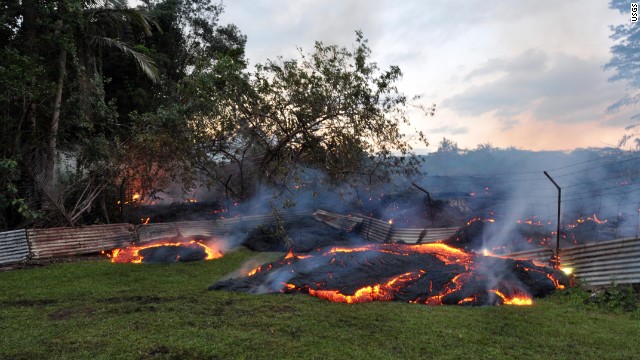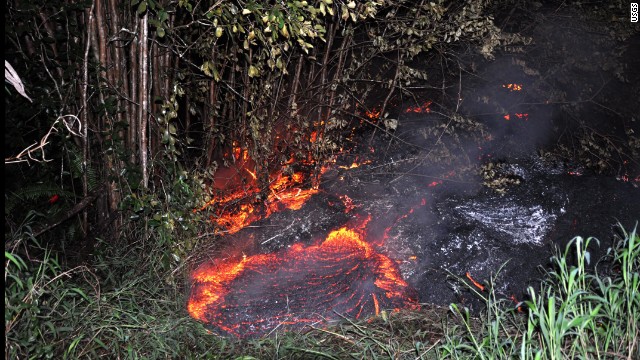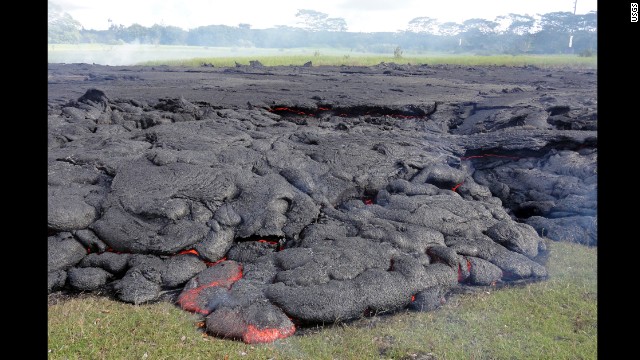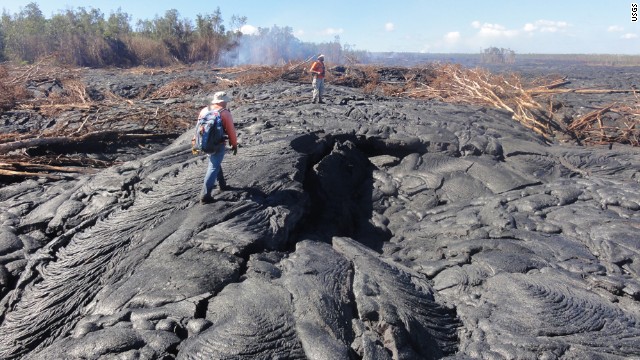- Lava from Kilauea volcano engulfed a house, USGS says
- The residents had long evacuated and cleared out belongings
- There are not other homes nearby in any danger, officials say
- Officials can only watch the lava flow and warn residents
(CNN) -- Lava from Hawaii's Kilauea volcano engulfed a home today in Pahoa village, according to the U.S. Geological Survey. It's the first home to be destroyed by the lava flow.
The residents had long evacuated and cleared out their belongings, officials said.
"The lava spread out and ignited the house before noon local time," said USGS spokeswoman Janet Baab. "There are no other homes in imminent danger. We are watching the flow closely and continue to monitor it."

 Lava burns vegetation as it approaches a property boundary early on the morning of Tuesday, October 28. A lava flow from the volcano Kilauea is advancing on the community of about 950 people on Hawaii's Big Island. By early Tuesday, the flow was about 70 yards (64 meters) from the closest home and moving to the northeast at 8 to 11 yards (7-10 meters) per hour, the Hawaiian Volcano Observatory said.
Lava burns vegetation as it approaches a property boundary early on the morning of Tuesday, October 28. A lava flow from the volcano Kilauea is advancing on the community of about 950 people on Hawaii's Big Island. By early Tuesday, the flow was about 70 yards (64 meters) from the closest home and moving to the northeast at 8 to 11 yards (7-10 meters) per hour, the Hawaiian Volcano Observatory said.  Pictured here on Tuesday morning, October 28, lava had crossed into two privately owned properties.
Pictured here on Tuesday morning, October 28, lava had crossed into two privately owned properties.  Smoke rises near Apa'a Street and Pahoa Village Road in Pahoa, Hawaii, on Monday, October 27.
Smoke rises near Apa'a Street and Pahoa Village Road in Pahoa, Hawaii, on Monday, October 27.  The horizontal incandescent cracks seen in the center and right portions of the photo, taken October 25, indicate that the flow was inflating: Fed by a continuing supply of lava beneath the cooling crust, the surface slowly rises.
The horizontal incandescent cracks seen in the center and right portions of the photo, taken October 25, indicate that the flow was inflating: Fed by a continuing supply of lava beneath the cooling crust, the surface slowly rises.  Hawaiian Volcano Observatory geologists walk over the surface of the flow to track surface breakouts along a portion of the flow margin, about a kilometer (0.6 miles) up the slope from the flow front, on October 24.
Hawaiian Volcano Observatory geologists walk over the surface of the flow to track surface breakouts along a portion of the flow margin, about a kilometer (0.6 miles) up the slope from the flow front, on October 24.  Another view of the leading tip of the flow as it moves into the open pasture on October 24.
Another view of the leading tip of the flow as it moves into the open pasture on October 24.  Pu'u O'o Crater, in the eastern rift zone of Kilauea, remains filled with thick fumes, but recent views with the naked eye and thermal camera confirm that little change has occurred in the crater over recent weeks. The fumes mask a handful of small, glowing openings on the crater floor.
Pu'u O'o Crater, in the eastern rift zone of Kilauea, remains filled with thick fumes, but recent views with the naked eye and thermal camera confirm that little change has occurred in the crater over recent weeks. The fumes mask a handful of small, glowing openings on the crater floor.  A closer view of surface activity on September 15. "A lot of smoke (is) coming off the front, a lot of cracking noises, methane explosions are going on," said Tim Orr of the U.S. Geological Survey (USGS). "So, it's a noisy situation out there just from all the burning vegetation."
A closer view of surface activity on September 15. "A lot of smoke (is) coming off the front, a lot of cracking noises, methane explosions are going on," said Tim Orr of the U.S. Geological Survey (USGS). "So, it's a noisy situation out there just from all the burning vegetation."  A view of the sinuous, channelized flow that was moving to the northeast from Kilauea on June 27. The flow threatening Pahoa has advanced about 13 miles (21 kilometers) since then. Kilauea is one of the world's most active volcanoes.
A view of the sinuous, channelized flow that was moving to the northeast from Kilauea on June 27. The flow threatening Pahoa has advanced about 13 miles (21 kilometers) since then. Kilauea is one of the world's most active volcanoes.  Lava crawls from Kilauea
Lava crawls from Kilauea  Reporter's Notebook: Hawaii Volcanoes
Reporter's Notebook: Hawaii Volcanoes  The science of lava
The science of lava There is nothing residents can do about the 2,000-degree Fahrenheit river of lava that's been inching towards their town since June 27.
While the main lava flow has been stalled for a week, a smaller side flow of lava oozed out toward the home, according to Hawaii County's Civil Defense Agency.
"It's very difficult for the homeowners, because it's a stop-and-go phenomenon," said Darryl Oliveira, the civil defense agency's administrator.
Evacuation advisories for residents down slope of the lava flow will continue as needed, officials said.
Kilauea has been an active volcano since 1983.
CNN's Mayra Cuevas contributed to this story
No comments:
Post a Comment